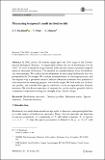Files in this item
Measuring temporal trends in biodiversity
Item metadata
| dc.contributor.author | Buckland, S. T. | |
| dc.contributor.author | Yuan, Y. | |
| dc.contributor.author | Marcon, Eric | |
| dc.date.accessioned | 2017-08-24T10:30:13Z | |
| dc.date.available | 2017-08-24T10:30:13Z | |
| dc.date.issued | 2017-10 | |
| dc.identifier | 243243230 | |
| dc.identifier | 9c9b8831-0da5-4496-b47a-8ffa0fedc563 | |
| dc.identifier | 85027314068 | |
| dc.identifier | 000412949200006 | |
| dc.identifier.citation | Buckland , S T , Yuan , Y & Marcon , E 2017 , ' Measuring temporal trends in biodiversity ' , Advances in Statistical Analysis , vol. 101 , no. 4 , pp. 461-474 . https://doi.org/10.1007/s10182-017-0308-1 | en |
| dc.identifier.issn | 1863-8171 | |
| dc.identifier.other | ORCID: /0000-0002-9939-709X/work/73701093 | |
| dc.identifier.uri | https://hdl.handle.net/10023/11534 | |
| dc.description | Yuan was part-funded by EPSRC/NERC Grant EP/1000917/1 and Marcon by ANR-10-LABX-25-01. | en |
| dc.description.abstract | In 2002, nearly 200 nations signed up to the 2010 target of the Convention for Biological Diversity, ‘to significantly reduce the rate of biodiversity loss by 2010’. In order to assess whether the target was met, it became necessary to quantify temporal trends in measures of diversity. This resulted in a marked shift in focus for biodiversity measurement. We explore the developments in measuring biodiversity that were prompted by the 2010 target. We consider measures based on species proportions, and also explain why a geometric mean of relative abundance estimates was preferred to such measures for assessing progress towards the target. We look at the use of diversity profiles, and consider how species similarity can be incorporated into diversity measures. We also discuss measures of turnover that can be used to quantify shifts in community composition arising for example from climate change. | |
| dc.format.extent | 344586 | |
| dc.language.iso | eng | |
| dc.relation.ispartof | Advances in Statistical Analysis | en |
| dc.subject | Biodiversity measures | en |
| dc.subject | Diversity profiles | en |
| dc.subject | Geometric mean | en |
| dc.subject | Species similarity | en |
| dc.subject | Turnover measures | en |
| dc.subject | QH301 Biology | en |
| dc.subject | T-NDAS | en |
| dc.subject | SDG 13 - Climate Action | en |
| dc.subject.lcc | QH301 | en |
| dc.title | Measuring temporal trends in biodiversity | en |
| dc.type | Journal article | en |
| dc.contributor.sponsor | EPSRC | en |
| dc.contributor.institution | University of St Andrews. School of Mathematics and Statistics | en |
| dc.contributor.institution | University of St Andrews. Marine Alliance for Science & Technology Scotland | en |
| dc.contributor.institution | University of St Andrews. Scottish Oceans Institute | en |
| dc.contributor.institution | University of St Andrews. St Andrews Sustainability Institute | en |
| dc.contributor.institution | University of St Andrews. Centre for Research into Ecological & Environmental Modelling | en |
| dc.contributor.institution | University of St Andrews. Statistics | en |
| dc.identifier.doi | https://doi.org/10.1007/s10182-017-0308-1 | |
| dc.description.status | Peer reviewed | en |
| dc.date.embargoedUntil | 2017-08-12 | |
| dc.identifier.grantnumber | EP/I000917/1 | en |
This item appears in the following Collection(s)
Items in the St Andrews Research Repository are protected by copyright, with all rights reserved, unless otherwise indicated.

